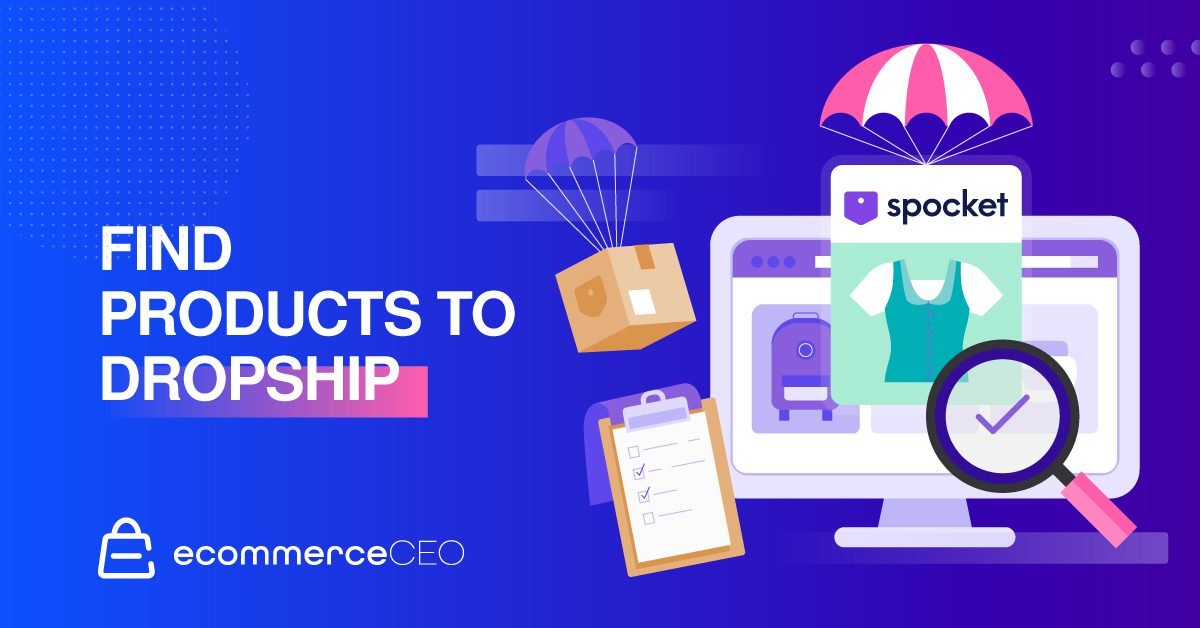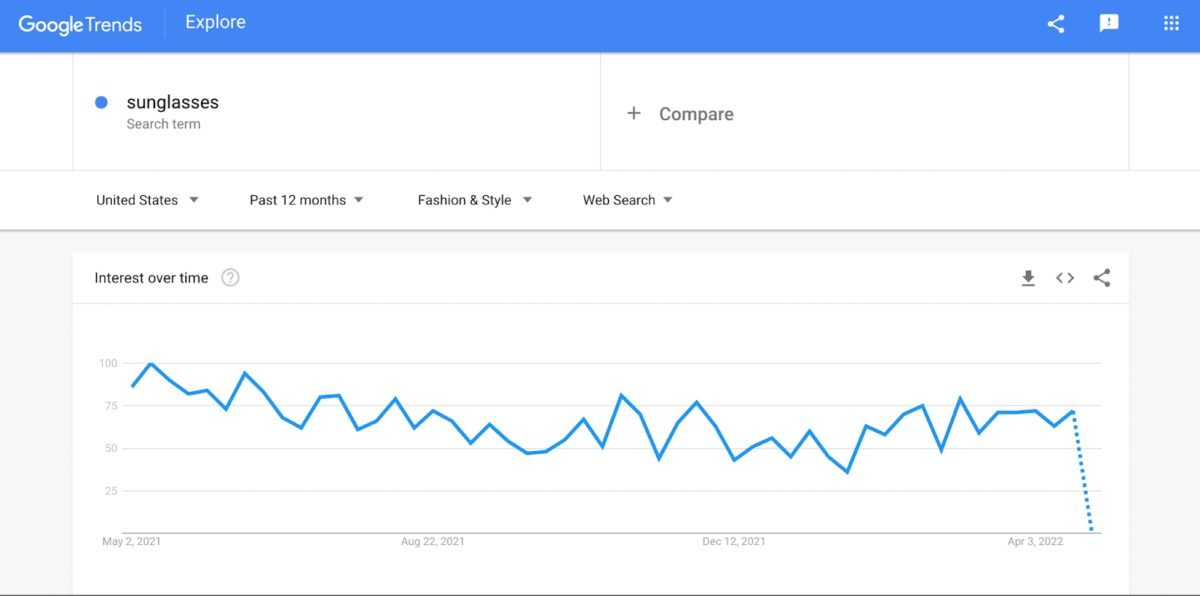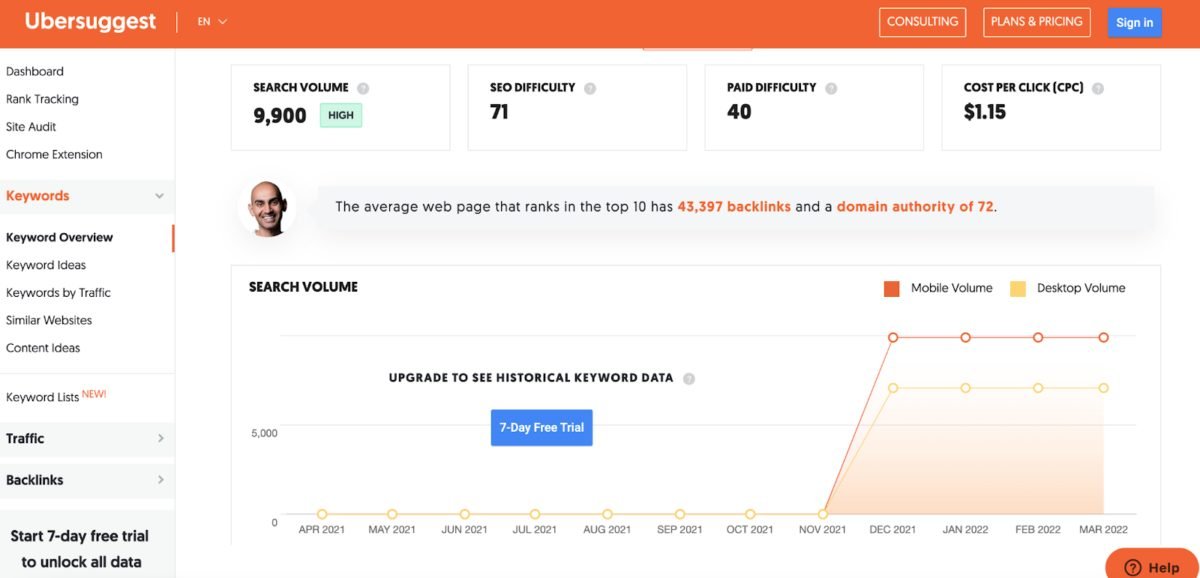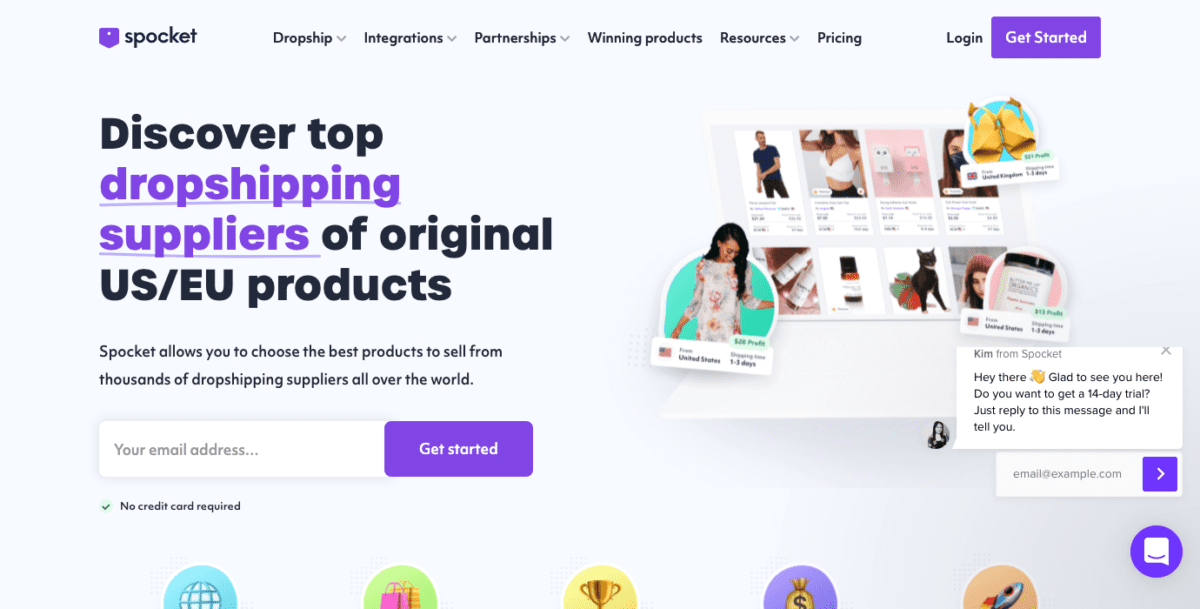Product sourcing is often one of the first steps that you would take when you’re starting your online business for the first time.
But the product research stage is often difficult and leads to a lot of rabbit holes where you end up having to spend unnecessary hours just to find the right products for your online store. In addition, entrepreneurs who are keen to capitalize on the eCommerce market have stiff competition. In fact, it’s estimated there are between 12 and 24 million ecommerce websites worldwide.

In light of that, online retailers are increasingly looking to streamline operations to have more time to focus on marketing and branding their online shops for a competitive edge.
One successful way to do exactly that in the ecommerce industry is to adopt the dropshipping model.
With this order fulfillment method, you don’t have to store inventory. Nor handle picking, packing, or shipping. Instead, the third-party suppliers you choose manage everything for you, sending orders placed on your eCommerce website directly to your customers.
But, let’s face it. Finding dropshipping products can be challenging, especially if you’re just starting out. Of course, you want to sell high-quality products…but affordable ones.
Fortunately, this guide explains how to find products to fuel a successful dropshipping business.
Ready to source winning products for your online store? Let’s dive in!
1. Define “Find Products”
It is important to note that “finding products” is entirely different in the dropshipping industry as compared to the traditional retail industry. Finding products to dropship means that you will be finding a supplier who can provide products you will be selling to your end customers without purchasing the inventory.
All of the product sourcing tips we’ll be covering in this article is focused on ensuring that you will be able to find products that can help you build a profitable dropshipping business. That way, you’ll get to focus less on the backend operations of your business, and focus more on running effective marketing campaigns and growing your business.
2. Identify a Niche Market

A niche is a particular segment of a larger market defined by its own unique preferences, interests, and needs. These factors separate it from the larger product category, ensuring you appeal to a smaller, more specific audience group.
While niche eCommerce stores appeal to fewer potential customers, they often enjoy less competition and saturation than larger market segments. As such, by picking and sticking to a specific niche, you can pour your efforts into understanding and fulfilling the needs of that particular audience and quickly become a trusted authority in that field.
To demonstrate the value of marketing to a small niche, let’s look at influencer marketing. Interestingly, nano-influencers with followings of only 1,000 – 5,000 people achieve 5% engagement, which is generally higher than influencers with audiences of several hundreds of thousands.
Why?
With a smaller niche, you can build more meaningful connections and interact more closely with your audience.
Some niches regularly make the list of popular dropshipping items. As a result, they’re sometimes referred to as evergreen niches.
Here are a few examples of these:
With the basics in mind, here are our top tips for picking a profitable dropshipping niche:
- Does the prospective niche lend itself to the occasional seasonal product? For example, are there products relevant to your niche that you could capitalize on during Halloween, Summer holidays, Christmas, etc.?
- Does the prospective niche have innovative winning products that are often introduced to the market?
- Rather than zoning in on just one dropshipping product, shortlist up to five or six.
- Make sure your niche lends itself to reasonable markup opportunities.
Pro Tip: Selling popular or trending dropshipping products is one way to get started. However, focusing on steady-sellers facilitates a more long-term approach. Alternatively, you can do both. I.e., profit from the latest trends and sell items with consistent demand. Either way, crazes only last so long, so you’ll need a backup plan to nurture your audience.
To summarize: successful dropshipping products fall into two camps:
- Products offering a solution: Some product ideas include, reusable water bottles, a backpack, mobile phone cases, laptop stands, etc. Knowing your niche allows you to pick products in response to your customers’ needs.
- Eye-catching items. Some product ideas include, brightly colored fidget toys or fun pet beds. Things like these are often talking points, so they’re more likely to be shared on their social media accounts. However, these trends tend to fizzle out, becoming unprofitable once the trend has passed.
3. Use Tools for Finding Profitable Dropshipping Products
With a potential niche in mind, it’s time to dig into some product research to find your winning products. Fortunately, there are several valuable product research tools you can use to enhance this process:
1. Google Trends
In short, Google Trends is an excellent product research tool. It provides at-a-glance information via graphs on search interest over time. This free platform is quick and straightforward to use. Simply search products you’re considering selling, and up pops data on interest over time (12 months, past 90 days, past month, and so on).
To illustrate, we looked for the search interest for “sunglasses” in the Fashion and Style category on Google Trends for over 12 months. In this instance, it appears searches have remained steady. This means sunglasses won’t be going out of fashion anytime soon and don’t enjoy sudden sparks of popularity. Instead, they remain a solid product choice with predictable interest.

2. Best Selling Product Lists
Researching best sellers on Amazon is always a good start. If you’re unsure where to begin to find dropshipping products to sell, platforms like Spocket provide insights into the products other sellers have enjoyed recent success with. For instance, Spocket dedicates an entire product category to its premium users for its bestseller recommendations. This is especially handy for those looking to quickly identify products to sell online with the highest appeal and quality.
3. Online Communities
One interesting way to find dropshipping products is to look at online communities. For example, Pinterest for trending products or Facebook pages showcasing popular items, like ‘I Want That.’
4. Bestproducts.com
Here, you’ll find niche products across many categories, including tech, home, beauty products, etc. The site also has a Facebook page that provides recommendations on trending products and why they’re in such high demand.
5. Your Local Community
Step out. Go to markets in your area, and visit community events like craft fairs. Look at what’s popular, and see whether you can source similar profitable products for your dropshipping venture.
6. Ubersuggest
This is a free keyword tool finder developed by Neil Patel, which is great for product analysis and identifying top-selling products. You can use it to:
- Find search volume for particular keywords
- Generate data on specific keywords
- Spot similar or related keywords
For example, we typed in “mobile phone case.” We found other popular related keywords such as “mobile phone case with card holder” and “mobile phone case with belt loop.” Simple!

7. Niche Scraper
Niche Scraper is one of the most popular dropshipping product research tools. It analyzes thousands of products daily on Shopify sites and AliExpress to identify dropshipping products likely to sell well. The people behind this platform are former Facebook and Instagram employees.
A free version offers limited searches, or you can pay for the PRO plan, which costs $49.95 a month.
Other dropshipping product research tools include SellTheTrend, Thieve, and more.
8. Check Out Your Competition

In addition to product research tools, one of the best ways to see what products are doing well is by looking at what your competitors or other Shopify stores who are advertising on Facebook and Instagram, and seeing the engagement level on their ads.
You can trigger Facebook to “flood” your social media with your competitor ads going to a sizeable dropshipping store, and putting any of the products into cart, but abandon the cart just right before check out.
A good dropshipping store will start their retargeting ads on you. And once you see those ads on your Social Media account, click on it to send a signal to Facebook that you are liking the ads that are presented to you. This will generally trigger even more similar ads to floor into your Social Media feed.
Once that happens, review the engagement on the ads. Are there a lot of recent comments and likes?
Remember that a dropshipping business will not continue to pour money into their ads if they aren’t profiting from them. And voila! This will give you an indication whether there is a market demand for these products.
4. Use The Best Dropshipping Suppliers

Now you have a list of products you want to dropship, it’s time to find a quality dropshipping supplier.
There are excellent dropshipping companies out there, catering to near-on every niche. This includes well-known names such as Spocket, which provides access to thousands of suppliers worldwide and integrates with popular eCommerce platforms like Spotify and Wix.
That said, here’s some advice on picking reliable dropshipping suppliers:
- Ensure they’re easy to contact and answer questions promptly. Reach out to their Customer Support team to review their response time. Remember that eCommerce never sleeps, you’d want to select a dropshipping supplier that can enable you to provide a great Customer Service to your end customer.
- Ensure you can order sample products to check the item quality. Spocket’s suppliers offer a 25% discount on up to five samples per product.
- Ascertain the supplier’s returns or refunds policy. WithSpocket, all suppliers will refund broken, wrong, or missing items.
- Check out reviews and ratings.
- Ensure your supplier’s ship expediently to the regions you operate in.
5. Set Your Prices

Now you have a supplier in mind, compare your supplier’s base price against the product prices advertised by other online sellers. Can you offer a similar price and still generate a healthy profit? With Spocket, you can easily calculate the potential profit by entering your intended selling price. You’ll then see the profit margin you’re left with after paying the manufacturer and can adjust your price accordingly.
Remember, when setting product prices, you need to factor in the wholesale product price, shipping costs, taxes, and marketing expenses. Then with these figures in mind, you’re better position to calculate a healthy markup.
Needless to say, if you set your product prices too low, profits will be negligible. Also, new customers may question why your products are so cheap and shy away in case they’re low quality. However, if you make the mistake of pricing products too high, you’ll lose customers to your competitors.
Before setting your prices, calculate your minimum retail price based on how much your wholesale, shipping, taxes, and marketing costs are. Then assess your competitor’s prices to guide your pricing strategy.
It’s also important to understand your buyer market. For example, how much are they likely to spend? What are their browsing habits? And so on.
You can obtain this information through advanced website analytics or researching the competition. You could even conduct a survey with your target audience and talk to potential customers via Facebook Groups and Forums.
6. Build Your Dropshipping Store

Choose your preferred eCommerce platform to build your dropshipping store. We have a dedicated article to help you find one that suit your needs.
Here are some questions that you’ll need to ask yourself:
- Does the platform provide access to dropshipping apps/suppliers?
- Does the platform have a free account option to reduce your costs?
- Is the platform beginner-friendly? I.e. Does the platform allow you to launch your store with only a few clicks without any development skills?
- Does the platform provide great support when you’re encountering issues?
Once you have decided on a platform of your choice, create an account and start building your website.
Designing your website is one of the funnest parts of building your online business. However, it’s crucial not to overspend time designing your store, as it’s the marketing of your business that leads to your success. Many eCommerce platforms offer free themes to make your store look professionally designed without having to spend too much time.
7. Edit Copy and Descriptions
Once you have done all the hard work with building your website and finding products to sell, it’s time to set your business apart from your competition. Creating original copywriting for your website and product descriptions is a great way to do that!
Bear in mind that, if you were to keep the original copywriting from your suppliers for the product description, you might get striked by Google with “duplicate content”, which prevents you from ranking in search engines. An easy way to combat this issue is to write your own SEO-optimized product descriptions. Stay away from naming your winning products after people’s names, such as “Lily dress,” and focus on describing the features from the product itself, such as “Crew-Neck Tshirt” because that is how your customers would be searching for these products on Google Search. For this, we recommend to rely on Google Trends or other keyword-optimization tools such as SEMRush.
8. Tell The World About Your Store and Products
You could be selling the best products in the world, but you won’t make sales if no one knows you exist. So you have to make some noise about your business to get those first sales rolling in.
That said, below, we’ve outlined a few marketing ideas you can use without spending tons of money.
Create a Buyer Persona
Imagine what your ideal buyer looks like. Ask yourself how much income they have? Do you expect them to be repeat customers or one-off impulse buyers? The kind of experience your ideal customer wants will determine what you do next in your dropshipping stores.
SEO
Optimizing your ecommerce business for SEO isn’t a quick fix. You need to ensure your product descriptions, titles, alt texts, and web copy use the specific keywords you want to rank for on search engines.
You can use different SEO tools to help, including Google Keyword Planner and, of course, Google Trends.
Email Marketing
Offer customers more by writing email newsletters containing direct links to your products, updates on the latest product trends, product guides, etc. Let’s take the latter as an example – you could provide a guide on ‘How to Make Your Garden Summer-Ready’ and include product ideas such as garden furniture. You could even include a discount code for first-time customers.
Social Media
Think about which social media platforms your buyers use. Yes, social media is a saturated marketplace, but careful preparation may help you stand out. So, do some background research and create a social media strategy for your eCommerce store. Also, look into tools that can help you manage your channels simultaneously, such as Buffer or Hootsuite.
Ready to Start Selling Dropshipping Products?
Finding the right dropshipping products can feel like an intimidating task. However, it’s imperative to get this step right. Unless you’re lucky, deciding impulsively which products to sell won’t bear as much fruit as a well-thought-out product strategy and market research. Good luck finding the best-selling products for your dropshipping business!









